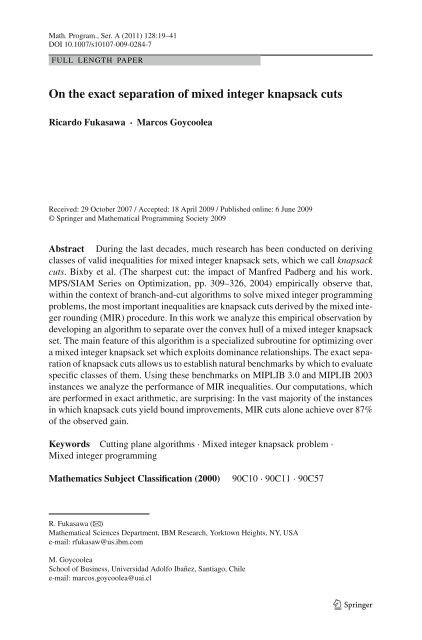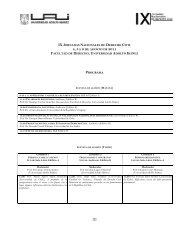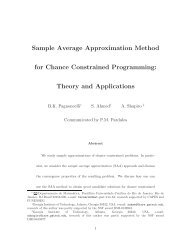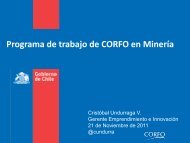On the exact separation of mixed integer knapsack cuts - Marcos ...
On the exact separation of mixed integer knapsack cuts - Marcos ...
On the exact separation of mixed integer knapsack cuts - Marcos ...
You also want an ePaper? Increase the reach of your titles
YUMPU automatically turns print PDFs into web optimized ePapers that Google loves.
Math. Program., Ser. A (2011) 128:19–41DOI 10.1007/s10107-009-0284-7FULL LENGTH PAPER<strong>On</strong> <strong>the</strong> <strong>exact</strong> <strong>separation</strong> <strong>of</strong> <strong>mixed</strong> <strong>integer</strong> <strong>knapsack</strong> <strong>cuts</strong>Ricardo Fukasawa · <strong>Marcos</strong> GoycooleaReceived: 29 October 2007 / Accepted: 18 April 2009 / Published online: 6 June 2009© Springer and Ma<strong>the</strong>matical Programming Society 2009Abstract During <strong>the</strong> last decades, much research has been conducted on derivingclasses <strong>of</strong> valid inequalities for <strong>mixed</strong> <strong>integer</strong> <strong>knapsack</strong> sets, which we call <strong>knapsack</strong><strong>cuts</strong>. Bixby et al. (The sharpest cut: <strong>the</strong> impact <strong>of</strong> Manfred Padberg and his work.MPS/SIAM Series on Optimization, pp. 309–326, 2004) empirically observe that,within <strong>the</strong> context <strong>of</strong> branch-and-cut algorithms to solve <strong>mixed</strong> <strong>integer</strong> programmingproblems, <strong>the</strong> most important inequalities are <strong>knapsack</strong> <strong>cuts</strong> derived by <strong>the</strong> <strong>mixed</strong> <strong>integer</strong>rounding (MIR) procedure. In this work we analyze this empirical observation bydeveloping an algorithm to separate over <strong>the</strong> convex hull <strong>of</strong> a <strong>mixed</strong> <strong>integer</strong> <strong>knapsack</strong>set. The main feature <strong>of</strong> this algorithm is a specialized subroutine for optimizing overa <strong>mixed</strong> <strong>integer</strong> <strong>knapsack</strong> set which exploits dominance relationships. The <strong>exact</strong> <strong>separation</strong><strong>of</strong> <strong>knapsack</strong> <strong>cuts</strong> allows us to establish natural benchmarks by which to evaluatespecific classes <strong>of</strong> <strong>the</strong>m. Using <strong>the</strong>se benchmarks on MIPLIB 3.0 and MIPLIB 2003instances we analyze <strong>the</strong> performance <strong>of</strong> MIR inequalities. Our computations, whichare performed in <strong>exact</strong> arithmetic, are surprising: In <strong>the</strong> vast majority <strong>of</strong> <strong>the</strong> instancesin which <strong>knapsack</strong> <strong>cuts</strong> yield bound improvements, MIR <strong>cuts</strong> alone achieve over 87%<strong>of</strong> <strong>the</strong> observed gain.Keywords Cutting plane algorithms · Mixed <strong>integer</strong> <strong>knapsack</strong> problem ·Mixed <strong>integer</strong> programmingMa<strong>the</strong>matics Subject Classification (2000)90C10 · 90C11 · 90C57R. Fukasawa (B)Ma<strong>the</strong>matical Sciences Department, IBM Research, Yorktown Heights, NY, USAe-mail: rfukasaw@us.ibm.comM. GoycooleaSchool <strong>of</strong> Business, Universidad Adolfo Ibañez, Santiago, Chilee-mail: marcos.goycoolea@uai.cl123
20 R. Fukasawa, M. Goycoolea1 IntroductionConsider a positive <strong>integer</strong> n, b ∈ Q, a ∈ Q n , l ∈{Q∪{−∞}} n , u ∈{Q∪{+∞}} nand I ⊆ N := {1,...,n}. In this article we consider <strong>the</strong> <strong>mixed</strong> <strong>integer</strong> <strong>knapsack</strong> setK ={x ∈ R n : ax ≤ b, l ≤ x ≤ u, x i ∈ Z, ∀i ∈ I }.More specifically, we are interested in solving <strong>the</strong> <strong>separation</strong> problem for conv(K ).That is, given a point x ∗ ∈ Q n , we are interested in ei<strong>the</strong>r (a) identifying an inequality(π, π o ) which is valid for conv(K ) (equivalently valid for K ) and violated by x ∗ ,or(b) proving no such inequality exists.By obtaining valid inequalities for <strong>mixed</strong> <strong>integer</strong> <strong>knapsack</strong> sets we can also obtainvalid inequalities for general Mixed Integer Programming (MIP) problems. In fact,consider <strong>the</strong> <strong>mixed</strong> <strong>integer</strong> setP ={x ∈ R n : Dx ≤ d, l ≤ x ≤ u, x i ∈ Z, ∀i ∈ I }.where D is an m × n matrix, and d ∈ Q n .If(a, b) can be obtained as a non-negativelinear combination <strong>of</strong> rows from (D, d), <strong>the</strong>n P ⊆ K and we say that K is an implied<strong>knapsack</strong> set <strong>of</strong> P. If this is <strong>the</strong> case, any inequality which is valid for K will also bevalid for P and we henceforth call it <strong>knapsack</strong> inequality or <strong>knapsack</strong> cut <strong>of</strong> P.Deriving strong <strong>knapsack</strong> inequalities is <strong>of</strong> great practical importance to <strong>the</strong> solution<strong>of</strong> MIPs. In fact, most cutting planes known for general MIPs are <strong>knapsack</strong> <strong>cuts</strong>. Forexample, Gomory Mixed Integer (GMI) <strong>cuts</strong> [30,43] are <strong>knapsack</strong> <strong>cuts</strong> derived from<strong>the</strong> tableaus <strong>of</strong> linear programming relaxations, and lifted cover inequalities [19,34]are <strong>knapsack</strong> <strong>cuts</strong> derived from <strong>the</strong> original rows <strong>of</strong> P. O<strong>the</strong>r classes <strong>of</strong> <strong>knapsack</strong> <strong>cuts</strong>include <strong>mixed</strong> <strong>integer</strong> rounding (MIR) <strong>cuts</strong> and <strong>the</strong>ir variations [17,41,44], split <strong>cuts</strong>[16], lift-and-project <strong>cuts</strong> [8], and group <strong>cuts</strong> [21,31]—to name but a few.In practice, <strong>the</strong> most successful class <strong>of</strong> <strong>knapsack</strong> <strong>cuts</strong> for MIPs are <strong>the</strong> GMI/MIR<strong>cuts</strong> [12]. Dash and Günlük [22] have recently done an empirical study to better understandthis practical success. They show that, in a significant number <strong>of</strong> instances, afteradding GMI <strong>cuts</strong> for all <strong>the</strong> optimal tableau rows, <strong>the</strong>re are no more violated group<strong>cuts</strong> for those tableau rows. Their results are quite surprising, and already suggest howstrong are GMI <strong>cuts</strong> within <strong>the</strong> context <strong>of</strong> group <strong>cuts</strong>.There are, however, natural questions left to answer: In <strong>the</strong> case where <strong>the</strong>re aresome violated group <strong>cuts</strong>, do <strong>the</strong>se <strong>cuts</strong> give any significant improvement in <strong>the</strong> continuousrelaxation bound? In <strong>the</strong> case where <strong>the</strong>re are no violated group <strong>cuts</strong>, are <strong>the</strong>reany o<strong>the</strong>r classes <strong>of</strong> <strong>knapsack</strong> <strong>cuts</strong> that are violated and can yield significantly betterbounds? In fact, S. Dash (personal communication) proposed a closely related conjecturethat for many problems in MIPLIB 3.0 <strong>the</strong> combined effect <strong>of</strong> GMI <strong>cuts</strong> fromdifferent tableau rows is to push <strong>the</strong> resulting solution x into <strong>the</strong> intersection <strong>of</strong> <strong>the</strong>convex hulls <strong>of</strong> <strong>the</strong> <strong>mixed</strong> <strong>integer</strong> <strong>knapsack</strong> sets defined by <strong>the</strong> tableau rows.To help resolve <strong>the</strong>se questions, we empirically assess <strong>the</strong> performance <strong>of</strong> MIRand GMI inequalities relative to that <strong>of</strong> all possible <strong>knapsack</strong> <strong>cuts</strong> using <strong>the</strong> objectivefunction <strong>of</strong> <strong>the</strong> continuous relaxation as a measure <strong>of</strong> quality. Formally, consider P as123
<strong>On</strong> <strong>the</strong> <strong>exact</strong> <strong>separation</strong> <strong>of</strong> MIK <strong>cuts</strong> 21Table 1 Computational studies <strong>of</strong> classes <strong>of</strong> <strong>cuts</strong>Paper Instance set Implied Knapsack Set (K) Class <strong>of</strong> <strong>cuts</strong>Boyd [15] Pure 0-1 Formulation KnapsackYan and Boyd [48] Mixed 0-1 Formulation KnapsackFischetti and Lodi [26] Pure <strong>integer</strong> All CGBonami et al. [14] General MIP All Pro-CGFischetti and Lodi [25] Pure 0-1 All KnapsackBalas and Saxena [9] General MIP All MIRDash et al. [22] General MIP All MIRKaparis and Letchford [39] Pure 0-1 Formulation KnapsackThis paper General MIP Formulation and Tableaus Knapsackdefined above, c ∈ Q n , and C a set <strong>of</strong> valid inequalities for P. Define,z ∗ (C) = min{cx : Dx ≤ d, l ≤ x ≤ u, πx ≤ π o ∀(π, π o ) ∈ C}.Observe that <strong>the</strong> value z ∗ (C) defines a benchmark by which to evaluate classes <strong>of</strong> <strong>cuts</strong>that are subsets <strong>of</strong> C. This idea will be applied in our context in <strong>the</strong> following way:Given a family <strong>of</strong> implied <strong>knapsack</strong> sets K, letC K and M K represent, respectively,<strong>the</strong> set <strong>of</strong> all <strong>knapsack</strong> <strong>cuts</strong> and MIR <strong>cuts</strong> which can be derived from sets K ∈ K.Since M K ⊆ C K it is easy to see that z ∗ (C K ) ≥ z ∗ (M K ) and that <strong>the</strong> proximity <strong>of</strong><strong>the</strong>se two values gives an indication <strong>of</strong> <strong>the</strong> strength <strong>of</strong> MIR inequalities derived fromthat particular family K.In this paper we compute <strong>the</strong> values z ∗ (C F ) and z ∗ (C T ), where F is <strong>the</strong> set <strong>of</strong>original formulation rows and T is <strong>the</strong> set <strong>of</strong> first tableau rows. Note that MIR <strong>cuts</strong>obtained from rows <strong>of</strong> a simplex tableau are simply GMI <strong>cuts</strong>. In this study we areable to obtain results for a large subset <strong>of</strong> MIPLIB 3.0 and MIPLIB 2003 instances.There have been several related papers computing <strong>the</strong> value <strong>of</strong> <strong>the</strong> continuous relaxationusing all <strong>cuts</strong> in a certain class <strong>of</strong> <strong>knapsack</strong> <strong>cuts</strong>. Boyd [15], Yan and Boyd [48]and Kaparis and Letchford [39] compute z ∗ (C F ), where F is <strong>the</strong> set <strong>of</strong> original formulationrows. They perform <strong>the</strong>se tests on a subset <strong>of</strong> pure and <strong>mixed</strong> 0–1 instancesin MIPLIB 3.0 [13]. Balas and Saxena [9] and Dash et al. [22] compute z ∗ (M A )for all MIPLIB 3.0 problems, where A is <strong>the</strong> set <strong>of</strong> all implied <strong>knapsack</strong> sets. Thisgeneralizes <strong>the</strong> results <strong>of</strong> Fischetti and Lodi [26] and Bonami et al. [14] where <strong>the</strong>yconsider Chvátal-Gomory <strong>cuts</strong> and projected Chvátal-Gomory <strong>cuts</strong>. Fischetti and Lodi[25] compute z ∗ (C A ) for a very reduced test set <strong>of</strong> pure 0–1 problems. We summarize<strong>the</strong>se results and compare <strong>the</strong>m to ours in Table 1.Finally, note that, since our method establishes benchmarks for <strong>knapsack</strong> <strong>cuts</strong>, weuse <strong>exact</strong> arithmetic to ensure that <strong>the</strong> results obtained are accurate. Indeed, Boyd [15]already cites numerical difficulties in P2756, a pure 0–1 instance, and as a consequence,he gets different bounds than us and Kaparis and Letchford [39].The organization <strong>of</strong> this paper is as follows. In <strong>the</strong> next section, we discuss how tosolve <strong>the</strong> problem <strong>of</strong> separating over a single <strong>mixed</strong> <strong>integer</strong> <strong>knapsack</strong> set. In Sect. 3 we123
22 R. Fukasawa, M. Goycooleadescribe our methodolgy for a practical implementation <strong>of</strong> <strong>the</strong> <strong>separation</strong> algorithm.Computational results are presented in Sect. 4, while final remarks are given in Sect. 5.2 Identifying a violated <strong>knapsack</strong> cutConsider x ∗ ∈ Q n and a feasible <strong>mixed</strong> <strong>integer</strong> <strong>knapsack</strong> set K . In this section we areconcerned with developing an effective algorithm for answering <strong>the</strong> following questions:Is x ∗ ∈ conv(K )? If not, can we find an inequality π x ≤ π o which is valid forK , and such that π x ∗ >π o ?Throughout this section we assume that x ∗ satisfies all constraints defining K exceptfor <strong>the</strong> integrality requirements. We also assume that for each i ∈ N ei<strong>the</strong>r l i ̸= −∞or u i ̸= ∞. Fur<strong>the</strong>r, we assume that <strong>the</strong> bound constraints are tight. That is, for everyfinite bound <strong>the</strong>re exists a point in K which meets that bound at equality. Finally, weassume that l i < u i for all i ∈ 1,...,n.Let {x 1 , x 2 ,...,x q } and {r 1 , r 2 ,...,r t } represent <strong>the</strong> extreme points and rays <strong>of</strong>conv(K ). Applegate et al. [3] suggest solving <strong>the</strong> following linear program to solve<strong>the</strong> <strong>separation</strong> problem.∑LP 1 : min n (u i + v i )s.t.i=1π x k − π o ≤ 0 ∀k = 1 ...q (C1)πr k ≤ 0 ∀k = 1 ...t (C2)π x ∗ − π o = 1 (C3)π + u − v = 0 (C4)u ≥ 0,v ≥ 0.Notice that if LP 1 is infeasible, <strong>the</strong>n x ∗ ∈ conv(K ), and thus <strong>the</strong>re exists no <strong>knapsack</strong>cut violated by x ∗ . O<strong>the</strong>rwise, <strong>the</strong> optimal solution (u,v,π,π o ) gives a valid<strong>knapsack</strong> cut π x ≤ π o separating x ∗ from conv(K ) and with maximum value <strong>of</strong>π x ∗ −π o||π|| 1.Because LP 1 has an exponential number <strong>of</strong> rows, it cannot be solved directly.Ra<strong>the</strong>r, it must be solved with a dynamic row generation algorithm which separatesconstraints (C1) and (C2) by solving, for fixed π, <strong>the</strong> sub-problem max{π x : x ∈ K }.We develop a specialized solver for this problem in Sect. 3. We also note that <strong>the</strong>straightforward dynamic cut generation algorithm that repeatedly optimizes over arelaxation <strong>of</strong> LP 1 and adds a violated cut (C1) or (C2) to <strong>the</strong> relaxation is prohibitivelyslow. For that reason, we present in Sects. 2.1–2.2 steps which were used tohelp speed up <strong>the</strong> procedure. We summarize <strong>the</strong> procedure in Algorithm 1.2.1 Eliminating variables from LP 1 .Say that a <strong>knapsack</strong> cut for K is trivial if it is implied by <strong>the</strong> linear programmingrelaxation <strong>of</strong> K . A pro<strong>of</strong> <strong>of</strong> <strong>the</strong> following result concerning non-trivial <strong>knapsack</strong> <strong>cuts</strong>can be found in Atamtürk [5].123
<strong>On</strong> <strong>the</strong> <strong>exact</strong> <strong>separation</strong> <strong>of</strong> MIK <strong>cuts</strong> 23Algorithm 1: <strong>knapsack</strong>_separator(K, x ∗ )Input: A <strong>mixed</strong> <strong>integer</strong> <strong>knapsack</strong> set K , and a vector x ∗ .Output: An answer to <strong>the</strong> question “Is x ∗ ∈ conv(K )?”. In case that <strong>the</strong> answer is FALSE, <strong>the</strong>algorithm also returns a cut separating x ∗ from conv(K ).1 Simplify <strong>the</strong> problem by fixing variables which are at <strong>the</strong>ir bounds, as indicated in Sect. 2.2, andreduce to a smaller dimensional <strong>knapsack</strong> <strong>separation</strong> problem;2 Formulate problem LP 1 in <strong>the</strong> reduced variable space without adding any <strong>of</strong> <strong>the</strong> constraints in(C1) − (C2);3 Apply Propositions 1 and 2 to simplify LP 1 by eliminating variables from consideration and addingbounds;4 Solve LP 1 using <strong>the</strong> dynamic row generation algorithm;5 If solving LP 1 reveals that x ∗ ∈ conv(K ), <strong>the</strong>n STOP and report that x ∗ ∈ conv(K );6 Let ( ˆπ, πˆo ) represent <strong>the</strong> optimal solution to LP 1 ;7 Lift cut ˆπ x ≤ πˆo to obtain a cut π x ≤ π o which is valid for K ;8 STOP and return <strong>the</strong> cut (π, π o );Proposition 1 Every non-trivial facet-defining <strong>knapsack</strong> cut π x ≤ π o <strong>of</strong> conv(K )satisfies <strong>the</strong> following properties:(i) If a i > 0, <strong>the</strong>n π i ≥ 0.(ii) If a i < 0, <strong>the</strong>n π i ≤ 0.(iii) π i = 0 for all i /∈ I such that a i > 0 and u i =+∞.(iv) π i = 0 for all i /∈ I such that a i < 0 and l i =−∞.(v) There exists a constant α>0 such that π i = αa i for all i /∈ I such that a i > 0and l i =−∞, and for all i /∈ I such that a i < 0 and u i =+∞.The following result concerning violated and non-trivial <strong>knapsack</strong> <strong>cuts</strong> is a simplegeneralization <strong>of</strong> a remark made in Boyd [15].Proposition 2 Consider x ∗ ∈ K LP \conv(K ), where K LP stands for <strong>the</strong> LP relaxation<strong>of</strong> K . Let H + ={i ∈ 1,...,n : a i > 0, xi ∗ = l i } and H − ={i ∈ 1,...,n :a i < 0, xi∗ = u i }. Then <strong>the</strong>re exists a <strong>knapsack</strong> cut π x ≤ π o separating x ∗ fromconv(K ) such that π i = 0, ∀i ∈ H + ∪ H − .Pro<strong>of</strong> Since x ∗ ∈ K LP \conv(K ), <strong>the</strong>n <strong>the</strong>re exists a valid non-trivial inequalityˆπ x ≤ ˆπ o for conv(K ) violated by x ∗ . We may assume that ˆπ x ≤ ˆπ o is nontrivial,since if <strong>the</strong>re is no such cut, we conclude <strong>the</strong> pro<strong>of</strong>. Define π o =ˆπ o − ∑ i∈H + ˆπ il i −ˆπ iu i and∑i∈H −{ 0 ifi ∈ Hπ i =+ ∪ H −ˆπ i o<strong>the</strong>rwise.We now prove π x ≤ π o is valid for K . For this, consider ¯x ∈ conv(K ). Consider i ∈H + . From Proposition 1 we know that a i > 0 implies ˆπ i ≥ 0, and thus, ˆπ i ¯x i ≥ˆπ i l i .Likewise, consider i ∈ H − . From Proposition 1 we know that a i < 0 implies ˆπ i ≤ 0,and thus, ˆπ i ¯x i ≥ˆπ i u i . Hence, ˆπ o ≥ˆπ ¯x ≥ π ¯x + ∑ i∈H + ˆπ il i + ∑ i∈H − ˆπ iu i , and so,π ¯x ≤ π o . <strong>On</strong> <strong>the</strong> o<strong>the</strong>r hand, ˆπ o < ˆπ x ∗ = π x ∗ + ∑ i∈H + ˆπ il i + ∑ i∈H − ˆπ iu i . Thus,π x ∗ >π o , and we conclude <strong>the</strong> result.⊓⊔123
24 R. Fukasawa, M. GoycooleaFrom Propositions 1 and 2 we can see that variables π i with i ∈ 1,...,n can beassumed to have value zero whenever any <strong>of</strong> <strong>the</strong> following conditions are met:– i /∈ I, a i > 0 and u i =+∞,– i /∈ I, a i < 0 and l i =−∞,– a i > 0 and x ∗ i= l i ,– a i < 0 and x ∗ i= u i .In <strong>the</strong>se cases <strong>the</strong> corresponding variables can simply be eliminated from LP 1 . Fur<strong>the</strong>r,from Proposition 1 it can be seen that if we add a non-negative continuous variable αto LP 1 , we can replace all variables π i satisfying condition (v) <strong>of</strong> Proposition 1 by <strong>the</strong>corresponding terms αa i . This can effectively reduce <strong>the</strong> variable space by eliminatingall remaining continuous unbounded variables. Finally, observe that Proposition1 allows us to add non-negativity bounds on all variables π i such that a i > 0, andnon-positivity bounds on all variables π i such that a i < 0.2.2 Fixing variables and lifting back againConsider a <strong>mixed</strong> <strong>integer</strong> set P, such as <strong>the</strong> one defined in Sect. 1:P ={x ∈ R n : Dx ≤ d, l ≤ x ≤ u, x i ∈ Z, ∀i ∈ I }.Let U, L be disjoint subsets <strong>of</strong> {1,...,n} such that u i ̸= ∞for all i ∈ U and suchthat l i ̸= −∞for all i ∈ L. DefineP(L, U) = P ∩{x ∈ R n : x i = l i ∀i ∈ L}∩{x ∈ R n : x i = u i ∀i ∈ U}.Given an inequality π x ≤ π o which is valid for P(L, U), lifting consists in obtainingfrom this an inequality ˆπ x ≤ πˆo which is valid for P.Given a <strong>mixed</strong> <strong>integer</strong> <strong>knapsack</strong> set K and a point x ∗ we are concerned in determiningif x ∗ ∈ conv(K ), or if we can find a separating hyperplane. For this we use liftingin <strong>the</strong> following way. Define U ={i ∈ 1,...,n : xi ∗ = u i } and L ={i ∈ 1,...,n :xi∗ = l i }. It is easy to see that x ∗ ∈ conv(K ) if and only if x ∗ ∈ conv(K (L, U)).However, this latter problem is easier to solve since its dimension is much smaller.In practice, this means we can apply <strong>the</strong> dynamic cut generation methodology on <strong>the</strong>smaller <strong>knapsack</strong> constraint:n∑i=1, i /∈L∪Ua i x i ≤ b − ∑ i∈La i l i − ∑ i∈Ua i u i .If solving this problem reveals that x ∗ ∈ conv(K (L, U)) <strong>the</strong>n we conclude thatx ∗ ∈ conv(K ). However, if it reveals that x ∗ /∈ conv(K (L, U)) we will obtain aninequality π x ≤ π o separating x ∗ from conv(K (L, U)) but which is not necessarilyvalid for K . In this case we simply apply lifting to obtain a new inequality which isvalid for K .123
<strong>On</strong> <strong>the</strong> <strong>exact</strong> <strong>separation</strong> <strong>of</strong> MIK <strong>cuts</strong> 25Lifting methodologies typically come in two flavors: Sequential lifting [10,47,49]and sequence-independent lifting [6,35]. In our study we used <strong>the</strong> sequential liftingprocedure described in Fukasawa [29], which allowed us to lift both continuous andgeneral <strong>integer</strong> variables. The sequence in which we lifted <strong>the</strong> variables was completelyarbitrary (from lowest to highest index).3 Solving <strong>the</strong> <strong>mixed</strong> <strong>integer</strong> <strong>knapsack</strong> problemConsider K as defined in Sect. 1, letc ∈ Q n , and assume l i is finite for each i ∈1,...,n. In this section we are concerned with solving <strong>the</strong> problemmax{cx : x ∈ K }, (1)which we call <strong>the</strong> Mixed Integer Knapsack Problem (MIKP).Variants <strong>of</strong> MIKP have long been studied in <strong>the</strong> research literature. In <strong>the</strong>se it istypically assumed that all coefficients defining <strong>the</strong> problem are <strong>integer</strong>, that all variablesmust take <strong>integer</strong> values (i.e. no continuous variables are allowed), and thatl i = 0 for all i = 1,...,n. In addition: In <strong>the</strong> Knapsack Problem (KP) u i = 1 for alli = 1,...,n, in <strong>the</strong> Bounded Knapsack Problem (BKP) u i < ∞ for all i = 1,...,n,and in <strong>the</strong> Unbounded Knapsack Problem (UKP) u i =∞for all i = 1,...,n. Mostmodern algorithms for solving KP, BKP, and UKP are based ei<strong>the</strong>r on branch andbound (following <strong>the</strong> work <strong>of</strong> Horowitz and Sahni [36]) and on dynamic programming(following <strong>the</strong> work <strong>of</strong> Bellman [11]). However, <strong>the</strong> most efficient codes seldommake explicit use <strong>of</strong> Linear Programming and in addition, <strong>the</strong>y never consider <strong>the</strong>use <strong>of</strong> both <strong>integer</strong> and continuous variables. For excellent surveys describing <strong>the</strong> richliterature on this topic, see Kellerer et al. [40] and Martello and Toth [42].While many <strong>of</strong> <strong>the</strong>se algorithms could be adapted for solving 1, <strong>the</strong>y require scalingso as to obtain all-<strong>integer</strong> coefficients. Our MIKP instances come from solving<strong>the</strong> <strong>separation</strong> problem over tableau rows, which are numerically very bad, requiringlarge scaling coefficients. Because <strong>of</strong> this we chose to develop an LP-based branchand bound approach. In what follows we describe our algorithm for solving MIKP.3.1 Detecting unbounded solutionsFor each i ∈ 1,...,n define <strong>the</strong> efficiency <strong>of</strong> variable x i as e i = c i /a i if a i ̸= 0, ase i =+∞if a i = 0 and c i > 0, and as e i =−∞if a i = 0 and c i < 0.Proposition 3 If MIKP is feasible, <strong>the</strong>n it is unbounded if and only if one <strong>of</strong> <strong>the</strong>following conditions hold,(a) There exists i ∈ 1,...,n such that(a i ≤ 0, c i > 0, u i =+∞)123
26 R. Fukasawa, M. Goycoolea(b) There exist i, j ∈ 1,...,n such that e i > e j ,(a i > 0, c i > 0, u i =+∞) and (a j < 0, c j ≤ 0, u j =+∞).Pro<strong>of</strong> It is clear that if ei<strong>the</strong>r condition holds <strong>the</strong>n <strong>the</strong> problem must be unbounded. Weprove <strong>the</strong> converse. Let U ={i ∈ 1,...,n : u i =+∞}, and consider <strong>the</strong> recessioncone <strong>of</strong> conv(K ), which is given by C ={x ∈ R n : ax ≤ 0, x i ≥ 0 ∀i ∈ U, x i =0 ∀i /∈ U}.The extreme rays <strong>of</strong> conv(K ) are <strong>the</strong> extreme rays <strong>of</strong> C and must satisfy n − 1<strong>of</strong><strong>the</strong> linearly independent constraints defining C at equality. Thus, all extreme ray vectorshave at most two-nonzero values. Let x correspond to an extreme ray satisfyingcx > 0. We may assume that (a) does not hold. Therefore, for any nonzero componentx i we have that c i > 0 ⇒ a i > 0 and a i ≤ 0 ⇒ c i ≤ 0. Given that cx > 0wemayassume that c i > 0. Thus a i > 0 and since ax ≤ 0, it follows that <strong>the</strong>re must exist jsuch that x j > 0 and a j < 0. Finally, cx > 0 implies that c i x i > −c j x j , and ax = 0implies that a i x i =−a j x j . From this we have that e i > e j , and this concludes ourpro<strong>of</strong>.⊓⊔Observe that Proposition 3 implies that it can be determined if MIKP is unboundedin linear time. In fact, this can be achieved by looping through <strong>the</strong> unbounded variablesand keeping track <strong>of</strong> <strong>the</strong> most efficient one satisfying (a i > 0, c i > 0), <strong>the</strong> least efficientone satisfying (a j < 0, c j ≤ 0), and checking if any satisfy (a i ≤ 0, c i > 0).3.2 PreprocessingWe utilize a simple eight-step pre-processing procedure in order to speed our algorithm.Let N + ={i ∈ 1,...,n : a i > 0}, and N − ={i ∈ 1,...,n : a i < 0}. Weassume that for each i ∈ I we have l i ∈ Z and u i ∈ Z ∪{∞}. If <strong>the</strong>re exists i ∈ N −such that u i =+∞, define L min =−∞. O<strong>the</strong>rwise, define,L min = ∑a i u i + ∑a i l ii∈N − i∈N +If <strong>the</strong>re exists i ∈ N + such that u i =+∞, define L max =+∞. O<strong>the</strong>rwise,L max = ∑a i l i + ∑a i u ii∈N − i∈N +Finally, let sign(x) = 1ifx > 0, sign(x) =−1ifx < 0 and sign(x) = 0ifx = 0.1. Detect infeasibility. The problem is infeasible if and only if one <strong>of</strong> <strong>the</strong> followingconditions hold: (a) L min ̸= −∞and L min > b, or (b) <strong>the</strong>re exists i ∈ 1,...,nsuch that u i ̸= ∞and l i > u i .2. Detect unboundedness. Use <strong>the</strong> algorithm discussed in Sect. 3.1 to detect if <strong>the</strong>problem is unbounded. Observe that if <strong>the</strong> problem is bounded, all variables x isatisfying c i ≥ 0 and a i ≤ 0 will be such that u i is finite.123
<strong>On</strong> <strong>the</strong> <strong>exact</strong> <strong>separation</strong> <strong>of</strong> MIK <strong>cuts</strong> 273. Fix variables at <strong>the</strong>ir bounds. Fix to u i all variables x i such that c i ≥ 0 anda i ≤ 0. Fix to l i to all variables x i such that c i ≤ 0 and a i ≥ 0. Observe that afterfixing, all variables will be such that (a i > 0 and c i > 0) or (a i < 0 and c i < 0).4. Tighten upper bounds. If L min ̸= −∞, <strong>the</strong>n <strong>the</strong> for each i ∈ N + we can re-defineu i := min{u i , (b − L min + a i l i )/a i }.Ifi ∈ I we can fur<strong>the</strong>r streng<strong>the</strong>n this byletting u i := ⌊u i ⌋.5. Tighten lower bounds. If L min ̸= ∞, <strong>the</strong>n <strong>the</strong> for each i ∈ N − we can re-definel i := max{l i , (b − L min + a i u i )/a i }.Ifi ∈ I we can fur<strong>the</strong>r streng<strong>the</strong>n this byletting l i := ⌈l i ⌉.6. Sort variables Sort variables in order <strong>of</strong> increasing efficiency. Break ties by letting<strong>integer</strong> variables precede continuous variables. Break second ties in order <strong>of</strong>increasing a i .7. Aggregate <strong>integer</strong> variables. If two <strong>integer</strong> variables x i , x j are such that a i = a jand c i = c j aggregate <strong>the</strong>m into a new variable x k <strong>of</strong> <strong>the</strong> same type such thata k = a i = a j , c k = c i = c j , l k = l i + l j and u k = u i + u j .8. Aggregate continuous variables. If two continuous variables x i , x j are such thatand sign(a i ) = sign(a j ) aggregate <strong>the</strong>m into a new variable x k <strong>of</strong> <strong>the</strong>c ia i= c ja jsame type such that a k = a i , c k = c i , l k = l i + a ja il j and u k = u i + a ja iu j .Note that steps one through five can be performed toge<strong>the</strong>r in a single loop, andthat step seven can be performed in a single pass after sorting. For more informationand for possible extensions see Savelsbergh [45]. From this point on, we will assumethat we are always dealing with instances that have been preprocessed according to<strong>the</strong> steps above.3.3 Branch and boundWe use a depth-first-search branch and bound algorithm which always branches on <strong>the</strong>unique fractional variable. We use a simple linear programming algorithm, a variation<strong>of</strong> Dantzig’s algorithm [20], which runs in linear time by taking advantage <strong>of</strong> <strong>the</strong> factthat variables are sorted by decreasing efficiency. We do not use any cutting planesin <strong>the</strong> algorithm, nor any heuristics to generate feasible solutions. The algorithm usesvariable reduced-cost information to improve variable bounds at each node <strong>of</strong> <strong>the</strong> tree.3.4 DominationConsider x 1 and x 2 , two feasible solutions <strong>of</strong> MIKP. We say that x 1 cost-dominatesx 2 if cx 1 > cx 2 and ax 1 ≤ ax 2 . <strong>On</strong> <strong>the</strong> o<strong>the</strong>r hand, we say that x 1 lexicographicallydominatesx 2 if cx 1 = cx 2 , ax 1 ≤ ax 2 , and if in addition <strong>the</strong>re exists i ∈{1,...,n}such that xi 1 < xi 2 and xk 1 = x2 kfor all k < i. We say that a solution is dominated if itis cost-dominated or lexicographically-dominated. Observe that <strong>the</strong>re exists a uniquenon-dominated optimal solution (or none at all).Traditional branch and bound algorithms work by pruning nodes when (a) <strong>the</strong>y areproven infeasible, or (b) when <strong>the</strong> LP relaxation <strong>of</strong> <strong>the</strong> nodes have value worse than123
28 R. Fukasawa, M. Goycoolea<strong>the</strong> best known feasible solution. In our implementation, we additionally prune nodeswhen (c) it can be shown that every optimal solution in those nodes is dominated.Using dominance to improve <strong>the</strong> branch and bound search can have an importantimpact on <strong>the</strong> effectiveness <strong>of</strong> <strong>the</strong> search [37]. In fact, lexicographic and cost dominanceallow us to disregard feasible solutions that are not <strong>the</strong> unique lexicographicallysmallest optimum solution, hence significantly reducing <strong>the</strong> search space.In general, <strong>the</strong> problem <strong>of</strong> detecting if a solution is dominated can be extremelydifficult. Fischetti et al. [27,28] detect domination by means <strong>of</strong> solving an MIP. Inwhat follows we describe a simple methodology for identifying specific cases <strong>of</strong> dominationarising in instances <strong>of</strong> <strong>the</strong> <strong>mixed</strong> <strong>integer</strong> <strong>knapsack</strong> problem. Note however, that<strong>the</strong> notion <strong>of</strong> dominance as defined above is much more general, and could be used forgeneral <strong>mixed</strong> <strong>integer</strong> programming problems as well [27,28,32]. As a final comment,note that Andonov et al [2] have also used domination in <strong>the</strong> context <strong>of</strong> dynamic programmingalgorithms, having had great success in tackling <strong>the</strong> unbounded <strong>knapsack</strong>problem.Throughout this section we will adopt <strong>the</strong> convention that ∞+r =∞, ∀r ∈ R.3.4.1 Domination between pairs <strong>of</strong> <strong>integer</strong> variablesConsider indices i, j ∈ I , and non-zero <strong>integer</strong>s k i , k j .Ifa i k i + a j k j ≥ 0 and c i k i +c j k j < 0 we say that (i, j, k i , k j ) defines an <strong>integer</strong> cost-domination tuple. If i < j,k i > 0, a i k i + a j k j ≥ 0 and c i k i + c j k j = 0 we say that (i, j, k i , k j ) defines an <strong>integer</strong>lexicographic-domination tuple. The propositions below show how dominationtuples allow for <strong>the</strong> easy identification <strong>of</strong> dominated solutions.Proposition 4 Consider an <strong>integer</strong> cost/lexicographic-domination tuple (i, j, k i , k j )and let x be a feasible MIKP solution. Define δ ∈ Z n such that δ i = k i , δ j = k j andδ q = 0 for all q ∈{1,...,n}\{i, j}.Ifl i + k i ≤ x i ≤ u i + k i and l j + k j ≤ x j ≤ u j + k j (2)Then x is cost/lexicographically-dominated by x − δ.To see that this proposition is true, it is simply a matter <strong>of</strong> observing that condition2 implies that (x − δ) is a feasible solution in terms <strong>of</strong> <strong>the</strong> bounds, and thata i k i + a j k j ≥ 0 and c i k i + c j k j ≤ 0 imply <strong>the</strong> domination.The following Theorem follows directly from Proposition 4, and illustrates howdomination tuples can be used to streng<strong>the</strong>n a branch and bound algorithm.Theorem 1 Consider two <strong>integer</strong> type variables x i and x j and a domination tuple(i, j, k i , k j ). If in some node <strong>of</strong> <strong>the</strong> branch and bound tree we have that l i + k i ≤ x i ≤u i + k i is satisfied by all solutions in that node, <strong>the</strong>n:• If k j > 0 we can impose <strong>the</strong> constraint x j ≤ l j + k j − 1 in that node,• If k j < 0 we can impose <strong>the</strong> constraint x j ≥ u j + k j + 1 in that node,and in ei<strong>the</strong>r case we will not cut <strong>of</strong>f <strong>the</strong> unique non-dominated optimal solution to<strong>the</strong> original MIP.123
<strong>On</strong> <strong>the</strong> <strong>exact</strong> <strong>separation</strong> <strong>of</strong> MIK <strong>cuts</strong> 29Observe that whenever (c i , c j ) and (a i , a j ) are linearly independent <strong>the</strong>re exist aninfinite number <strong>of</strong> cost-domination tuples. Likewise, <strong>the</strong>re exist an infinite number <strong>of</strong>lexicographic-domination tuples in <strong>the</strong> linear dependent case.The two following propositions state that, in each case, <strong>the</strong>re always exists a minimaldomination tuple. That is, a domination tuple (i, j, k i , k j ) such that all o<strong>the</strong>rdomination tuples (i, j, k ′ i , k′ j ) defined for <strong>the</strong> same variables, satisfy |k i|≤|k ′ i | and|k j |≤|k ′ j |. The pro<strong>of</strong> follows from <strong>the</strong> observation that since (c i, c j ) and (a i , a j )are in <strong>the</strong> same orthant (<strong>the</strong>y have <strong>the</strong> same sign in each coordinate), <strong>the</strong> intersection<strong>of</strong> <strong>the</strong> half spaces c i x i + c j x j < 0 and a i x i + a j x j ≥ 0 must also be contained inan orthant. Thus, it easily follows that <strong>the</strong>re must be a minimal domination tuple. Wenow prove this more formally.Proposition 5 If (a i , a j ) and (c i , c j ) are linearly independent, let,D = { (k i , k j ) ∈ Z × Z : k i , k j ̸= 0, a i k i + a j k j ≥ 0 and c i k i + c j k j < 0 }The following two properties hold:(i) D is contained in <strong>the</strong> interior <strong>of</strong> ( an orthant ) in N × N. More precisely, forevery (k i , k j ) ∈ D we have that: c i − c ja ja i < 0 if and only if k i > 0 and( )c j − c ia ia j < 0 if and only if k j > 0.(ii) There exists (ki o, ko j ) in D such that (k i, k j ) in D implies |ki o|≤|k i| and |k o j |≤|k j |.Pro<strong>of</strong> Consider (k i , k j ) ∈ D. Observe that since sign(a i ) = sign(c i ) we can multiplyconstraint a i k i + a j k j ≥ 0by− c ja jand add it to c i k i + c j k j < 0 and we get that( ) ( )c i − c ja ja i k i < 0. Likewise c j − c ia ia j k j < 0. Thus, (i) follows.Consider (x i , x j ) and (y i , y j ) in D.Letz i = x i if |x i |≤|y i |. O<strong>the</strong>rwise, let z i = y i .Let z j = x j if |x j |≤|y j |. O<strong>the</strong>rwise, let z j = y j . Since D is contained in a pointedcone in one <strong>of</strong> <strong>the</strong> four orthants, it is easy to see that (z i , z j ) ∈ D. Thus <strong>the</strong>re mustexist (ki o, ko j) in D satisfying <strong>the</strong> required condition.⊓⊔Proposition 6 If (a i , a j ) and (c i , c j ) are linearly dependent, let,D ={(k i , k j ) ∈ N × Z : k i , k j ̸= 0, a i k i + a j k j = 0 and c i k i + c j k j = 0}There exists (k o i , ko j ) in D such that (k i, k j ) in D implies |k o i |≤|k i| and |k o j |≤|k j|.Pro<strong>of</strong> Given <strong>the</strong> linear dependence <strong>of</strong> (a i , a j ) and (c i , c j ) we have that,D ={(k i , k j ) ∈ N × Z : k i , k j ̸= 0, k ik j=− a ja i}That this set is non-empty follows from <strong>the</strong> fact that a i and a j are∣rational∣numbers. ∣Let(ki o ∣∣ , ko j ) be <strong>the</strong> point in D with <strong>the</strong> smallest ko i . Clearly, |ko j |= a i ∣∣a j |ko i|≤∣ a i ∣∣a |ki j|=|k j | for all (k i , k j ) ∈ D. ⊓⊔123
30 R. Fukasawa, M. GoycooleaFrom Proposition 6 we see that if (a i , a j ) and (c i , c j ) are linearly dependent, <strong>the</strong>nit is trivial to compute a minimal domination pair. From Proposition 5 it follows thatif (a i , a j ) and (c i , c j ) are linearly independent, a minimal domination tuple can beobtained by solving <strong>the</strong> following two-dimensional <strong>integer</strong> programming problem:minimize |k i |+|k j |subject to,c i k i + c j k j ≥ 0a i k i + a j k j ≤ 0|k i |≥1, |k j |≥1,k i , k j ∈ Z(3)Fur<strong>the</strong>r, given that we know <strong>the</strong> feasible region <strong>of</strong> Problem 3 is contained in anorthant <strong>of</strong> Z × Z, we can remove <strong>the</strong> absolute values and make <strong>the</strong> problem linear.While in <strong>the</strong>ory Problem 3 can be solved in polynomial time [24,38,46], in practicewe found it easer to solve <strong>the</strong> problem by simple enumeration. For this, loop throughall possible values <strong>of</strong> k i , starting from k i = 1. <strong>On</strong>ce k i is fixed it is trivial to solve <strong>the</strong>problem for k j (or determine infeasibility). From <strong>the</strong> propositions above it suffices tostop at <strong>the</strong> first value <strong>of</strong> k i for which <strong>the</strong> problem is feasible.In order to use <strong>the</strong> above propositions in <strong>the</strong> branch and bound algorithm we computewhat we call a domination table. This table is defined as a list <strong>of</strong> all possible (minimal)domination tuples. In order to obtain a domination table we must loop through all possiblepairs <strong>of</strong> variables before solving <strong>the</strong> problem. Observe that because we will onlyuse <strong>the</strong>se tables to streng<strong>the</strong>n bounds after branching, as in Theorem 1, we only needto store domination tuples (i, j, k i , k j ) such that |k i |≤(u i − l i ) and |k j |≤(u j − l j ).As a final note, we observe that once domination is enforced through branching, <strong>the</strong>branch-and-bound tree will be <strong>of</strong> finite size, regardless <strong>of</strong> <strong>the</strong>re existing unboundedvariables. In fact, in any branch-and-bound tree <strong>of</strong> infinite size <strong>the</strong>re must exist abranching-path <strong>of</strong> infinite length. Fur<strong>the</strong>r, because <strong>the</strong>re are only a finite number <strong>of</strong><strong>integer</strong> variables, <strong>the</strong>re must exist two unbounded ones on which <strong>the</strong> tree branches aninfinite number <strong>of</strong> times. Since for every pair <strong>of</strong> <strong>integer</strong> variables <strong>the</strong>re exists a minimaldomination tuple, it is not difficult to see that if we enforce domination, at some pointbranching on one <strong>of</strong> <strong>the</strong>se variables would impose a bound on <strong>the</strong> o<strong>the</strong>r variable, thusmaking <strong>the</strong> impossible. path. Goycoolea [32] analogously shows that using dominationtables one could explicitely impose bounds a priori, which also guarantees finitetermination <strong>of</strong> branch-and-bound.3.4.2 Domination between <strong>integer</strong> and continuous variablesLet C j,k ={i ∈ C : j ≤ i ≤ k}. In this section we show how branching on <strong>integer</strong>variable x i can be used to streng<strong>the</strong>n <strong>the</strong> bounds on continuous variables x j withj ∈ C 1,i or those with j ∈ C i+1,n . Our attention will focus on instances <strong>of</strong> MIKPsatisfying a i > 0 for all i ∈ 1,...,n. This assumption is made only to simplify <strong>the</strong>123
<strong>On</strong> <strong>the</strong> <strong>exact</strong> <strong>separation</strong> <strong>of</strong> MIK <strong>cuts</strong> 31notation and analysis. All results can easily be extended to <strong>the</strong> more general case inwhich coefficients can be positive or negative.Proposition 7 Consider a pre-processed instance <strong>of</strong> MIKP, max{cx : x ∈ K }. Forany x ∈ K and i ∈ I we have that x is cost-dominated if <strong>the</strong>re exists k ∈ C i,n suchthat e k < e i , l k < x k , and,x i ≤ u i − 1 and∑We have that x is dominated if <strong>the</strong> following condition holds:x i ≥ l i + 1 andj∈C i,na j (x j − l j ) ≥ a i (4)∑j∈C 1,ia j (u j − x j ) ≥ a i (5)Pro<strong>of</strong> Assume that x i ≤ u i − 1 and ∑ j∈C i,na j (x j − l j ) ≥ a i . Define δ ∈ R n asfollows: let δ i =−1, δ j = 0 ∀ j ∈ I \{i}, and δ j = 0 ∀ j ∈ C\C i,n .For j ∈ C i,ndefine δ j so that (i) 0 ≤ δ j ≤ x j − l j , (ii) ∑ j∈C i,na j δ j = a i , and (iii) δ k > 0. Definex ′ = x − δ. It is easy to see that x ′ satisfies <strong>the</strong> integrality constraints. Fur<strong>the</strong>r, (i)implies that x ′ satisfies all <strong>of</strong> <strong>the</strong> bound constraints, and (ii) implies that ax ′ = ax.Thus, x ′ ∈ K . Finally, since <strong>the</strong> variables are sorted by decreasing efficiency, wehave that cx ′ ≥ cx, and from (iii) we obtain that this inequality is strict. Hence, x ′cost-dominates x. The pro<strong>of</strong> that 5 implies x is dominated is analogous. ⊓⊔Consider i ∈ I . Define,f (i) = min{k ∈ C i,n :Likewise, define:g(i) = max{k ∈ C 1,i :∑j∈C i,ka j (u j − l j )>a i }∑j∈C k,ia j (u j − l j )>a i }Proposition 8 Consider a pre-processed instance <strong>of</strong> MIKP, max{cx : x ∈ K }, andi ∈ I . Let f = f (i) and g = g(i). If in some node <strong>of</strong> <strong>the</strong> branch and bound treewe have that x i ≤ u i − 1 is satisfied by all solutions in that node, and in addition,e f < e i , <strong>the</strong>n we may also impose that:and,x j = l j ∀ j ∈ C f +1,n (6)x f ≤ l f + a i − ∑ j∈C i, f −1a j (u j − l j )a f(7)123
32 R. Fukasawa, M. GoycooleaLikewise, if in some node <strong>of</strong> <strong>the</strong> branch and bound tree we have that x i ≥ l i + 1 issatisfied by all solutions in that node, <strong>the</strong>n we may also impose that:and,x j = u j ∀ j ∈ C 1,g−1 , (8)x g ≥ u g − a i − ∑ j∈C g,ia j (u j − l j )a g. (9)In ei<strong>the</strong>r case we will only be cutting <strong>of</strong>f dominated solutions to <strong>the</strong> original MIP.Pro<strong>of</strong> We will prove that if e f < e i , <strong>the</strong>n any solution x ∈ K that satisfies x i ≤ u i −1and does not satisfy 6 or 7 is cost-dominated.First, let L f = l f + a i − ∑ j∈C a i, f −1 j (u j −l j )a fand L j = l j , ∀ j ∈ C f +1,n . Assume,for <strong>the</strong> sake <strong>of</strong> contradiction, that x t > L t for some t ∈ C f,n .Ifx j < u j for any j ∈C 1,t−1 , <strong>the</strong>n we can define ¯x so that ¯x k = x k , ∀k ̸= j, t, ¯x t = x t −ɛ, ¯x j = x j +ɛa t /a jand have that for some ɛ>0 small enough, ¯x ∈ K . Since <strong>the</strong> variables are sortedby decreasing efficiency, and observing that no two continuous variables can have <strong>the</strong>same efficiency, ¯x cost-dominates x.Therefore we may assume that x j = u j for all j ∈ C 1,t−1 . But <strong>the</strong>n since t ≥ f ,wehave that ∑ j∈C i,na j (x j −l j ) = ∑ j∈C i,t−1a j (u j −l j )+ ∑ j∈C t,na j (x j −l j )>a i andthat e t ≤ e f < e i . Therefore, by Proposition 7 we will have that x is cost-dominated.The second part <strong>of</strong> <strong>the</strong> Proposition is analogous.⊓⊔4 Computational experimentsIn this section we describe <strong>the</strong> results <strong>of</strong> our computational experiments. All implementationswere developed in <strong>the</strong> “C” and “C++” programming languages, using <strong>the</strong>Linux operating system (v2.4.27) on Intel Xeon dual-processor computers (2GB <strong>of</strong>RAM, at 2.66GHz). Since generating <strong>cuts</strong> which are invalid is a real point <strong>of</strong> concern,we use <strong>exact</strong> arithmetic ra<strong>the</strong>r than <strong>the</strong> floating point arithmetic typically usedin computer codes. Specifically, we used <strong>the</strong> <strong>exact</strong> LP solver <strong>of</strong> Applegate et al. [4]for solving LP 1 , and <strong>the</strong> GNU Multiple Precision (GMP) Arithmetic library [33] forimplementing all o<strong>the</strong>r computations.In order to test our results we use <strong>the</strong> MIPLIB 3.0 [13] and MIPLIB 2003 [1]data sets. Results are organized as follows. In Sect. 4.1 we utilize <strong>the</strong> methodologydeveloped in Sect. 2 to benchmark <strong>the</strong> MIR inequalities. In Sect. 4.2 we analyze <strong>the</strong>performance <strong>of</strong> <strong>the</strong> <strong>mixed</strong> <strong>integer</strong> <strong>knapsack</strong> algorithm developed in Sect. 3.4.1 Benchmarking <strong>the</strong> MIR inequalitiesWe now describe our experiments computing <strong>the</strong> values z ∗ (C K ) and z ∗ (M K ) and ouruse <strong>of</strong> <strong>the</strong>se values to benchmark <strong>the</strong> performance <strong>of</strong> MIR inequalities, as detailed123
<strong>On</strong> <strong>the</strong> <strong>exact</strong> <strong>separation</strong> <strong>of</strong> MIK <strong>cuts</strong> 33Table 2 Benchmarks for formulation rowsInstance ORIG-GAP (%) MIR-PERF (%) KNAP-PERF(%) MIR-REL (%)arki001 0.02 12.99 13.12 99.01fiber 61.55 91.07 93.82 97.06gen 0.16 99.78 99.78 100gesa2 1.18 69.96 71.03 98.48gesa3 0.56 47.80 49.33 96.90gt2 36.41 92.56 94.52 97.93l152lav 1.39 0.01 1.36 0.41lseu 25.48 67.91 76.09 89.25mitre 0.36 89.14 100.00 89.14mod008 5.23 71.23 89.21 79.84mod010 0.24 18.34 18.34 100nsrand-ipx 4.53 47.94 48.75 98.32p0033 18.40 76.33 87.42 87.31p0201 9.72 33.78 33.78 100p0282 31.56 94.08 98.59 95.42p0548 96.37 52.84 84.34 62.66p2756 13.93 44.46 86.35 51.49qnet1 10.95 50.48 89.06 56.68qnet1_o 24.54 84.32 95.12 88.65rgn 40.63 57.49 57.49 100roll3000 13.91 58.27 61.62 94.56sp97ar 1.38 2.19 2.49 88.08timtab1 96.25 21.88 22.07 99.13timtab2 93.49 13.82 13.96 99in Sect. 1. In <strong>the</strong>se experiments we only consider <strong>the</strong> sets K = F, i.e., <strong>the</strong> family <strong>of</strong><strong>knapsack</strong> sets induced by <strong>the</strong> original formulation rows, and K = T , i.e., <strong>the</strong> family<strong>of</strong> <strong>knapsack</strong> sets induced by <strong>the</strong> tableau rows <strong>of</strong> <strong>the</strong> optimal LP relaxation solution.As a first step, we implemented <strong>the</strong> MIR <strong>separation</strong> heuristic described in Goycoolea[32] to compute an approximation <strong>of</strong> z ∗ (M K ) which we call z K M . We compute zK M byrepeatedly adding MIR inequalities valid for each K ∈ K to <strong>the</strong> LP relaxation andre-optimizing it until no more <strong>cuts</strong> are found.As a second step, we compute z ∗ (C K ) by repeatedly adding <strong>knapsack</strong> <strong>cuts</strong> foundfor each K ∈ K to <strong>the</strong> LP relaxation and re-optimizing it until no more <strong>cuts</strong> are found.We note that before using <strong>the</strong> <strong>exact</strong> <strong>separation</strong> routine for some K ∈ K one can checkif <strong>the</strong>re is an MIR inequality (or any o<strong>the</strong>r known <strong>knapsack</strong> cut) valid for K that isviolated by <strong>the</strong> current LP relaxation. This helps speed up computations significantly.Tables 2 and 3 present <strong>the</strong> results for K = F and K = T respectively. For eachproblem instance let zUB ∗ represent <strong>the</strong> value <strong>of</strong> <strong>the</strong> optimal (or best known) solutionand z ∗ LP<strong>the</strong> LP relaxation value. For each set K and each instance we compute <strong>the</strong>following performance measures:123
34 R. Fukasawa, M. GoycooleaTable 3 Benchmarks for Tableau rowsInstance ORIG-GAP (%) MIR-PERF (%) KNAP-PERF (%) MIR-REL (%)air03 0.38 100.00 100.00 100a1c1s1 91.33 18.94 18.94 100aflow30a 15.10 13.41 14.77 90.78aflow40b 13.90 7.91 8.02 98.71bell3a 1.80 60.15 60.15 100bell5 3.99 14.53 14.68 98.94blend2 8.99 20.63 20.63 100dcmulti 2.24 50.46 50.49 99.94egout 73.67 55.33 55.33 100fiber 61.55 75.89 77.27 98.21fixnet6 69.85 11.08 11.08 100flugpl 2.86 11.74 11.74 100gen 0.16 61.67 61.97 99.52gesa2 1.18 28.13 28.13 99.98gesa2_o 1.18 29.55 29.65 99.67gesa3 0.56 45.76 45.83 99.85gesa3_o 0.56 49.96 49.99 99.94khb05250 10.31 75.14 75.14 100liu 69.60 27.02 27.02 100lseu 25.48 61.21 61.21 100manna81 1.01 100 100 100misc03 43.15 7.24 7.24 100misc06 0.07 26.98 26.98 100misc07 49.64 0.72 0.72 100mod008 5.23 22.57 22.59 99.92mod011 13.86 22.17 22.17 100modglob 1.49 18.05 18.05 100nsrand-ipx 4.53 38.94 39.26 99.20nw04 3.27 22.37 22.37 100p0033 18.40 74.71 74.71 100p0201 9.72 34.36 34.36 100pp08a 62.61 50.97 50.97 100qiu 601.15 3.47 3.47 100rentacar 5.11 27.42 27.42 100rgn 40.63 9.78 9.78 100set1ch 41.31 39.18 39.18 100swath 28.44 33.22 33.58 98.91timtab1 96.25 24.74 24.80 99.76timtab2 93.49 15.57 15.76 98.79tr12-30 89.12 60.27 60.27 100vpm1 22.92 47.27 49.09 96.30vpm2 28.08 19.17 19.39 98.85123
<strong>On</strong> <strong>the</strong> <strong>exact</strong> <strong>separation</strong> <strong>of</strong> MIK <strong>cuts</strong> 35ORIG-GAP: The value <strong>of</strong> <strong>the</strong> LP relaxation gap:z ∗ UB − z∗ LP|z ∗ UB | .MIR-PERF: How much <strong>of</strong> <strong>the</strong> LP gap was closed by <strong>the</strong> MIR heuristic:z K M − z∗ LPzUB ∗ − .z∗ LPKNAP-PERF: How much <strong>of</strong> <strong>the</strong> LP gap was closed by <strong>the</strong> <strong>knapsack</strong> <strong>cuts</strong>:z ∗ (C K ) − z ∗ LPzUB ∗ − .z∗ LPMIR-REL: Relative performance <strong>of</strong> MIR <strong>separation</strong> heuristic. That is, how much<strong>of</strong> <strong>the</strong> LP gap closed by <strong>the</strong> <strong>knapsack</strong> <strong>cuts</strong> was closed by <strong>the</strong> MIR <strong>cuts</strong>:z K M − z∗ LPz ∗ (C K ) − z ∗ LP4.1.1 Knapsack <strong>cuts</strong> derived from formulation rowsWe now discuss <strong>the</strong> computational results obtained for K = F. Of <strong>the</strong> 92 instancesin MIPLIB 3.0 and MIPLIB2003, we were able to compute <strong>the</strong> values z K Mfor 79<strong>of</strong> <strong>the</strong>m. The 13 problems which we were unable to solve were atlanta-ip, cap6000,dano3mip, harp2, momentum2, momentum3, markshare1, markshare2, mkc, msc98-ip, net12, rd-rplusc-21 and stp3d. Of <strong>the</strong> 79 problems solved, 4 <strong>of</strong> <strong>the</strong>m were such thatORIG-GAP was equal to 0.0 (disctom, dsbmip, enigma, and noswot), and 51 <strong>of</strong> <strong>the</strong>mwere such that KNAP-PERF and MIR-PERF were both equal to 0.0. In Table 2 wepresent <strong>the</strong> results for <strong>the</strong> remaining 24 problems.First, note that <strong>knapsack</strong> <strong>cuts</strong> alone can considerably close <strong>the</strong> remaining LP gap insome problems (column KNAP-PERF). In fact, in 11 problems out <strong>of</strong> <strong>the</strong> 24 problemsin which <strong>knapsack</strong> <strong>cuts</strong> improved <strong>the</strong> gap, over 84% <strong>of</strong> <strong>the</strong> gap was closed, and in 15out <strong>of</strong> 24 problems, over 50% <strong>of</strong> <strong>the</strong> gap was closed. <strong>On</strong> average, <strong>the</strong> GAP closed by<strong>the</strong> <strong>knapsack</strong> <strong>cuts</strong> among <strong>the</strong>se 24 instances is around 62%. Note, however, that in51 instances <strong>knapsack</strong> <strong>cuts</strong> do nothing to improve <strong>the</strong> gap. If we consider <strong>the</strong> averageGAP closed including <strong>the</strong>se 51 instances, <strong>the</strong> average drops to 19.84%.Second, consider <strong>the</strong> column MIR-REL in which we can get an idea how close is<strong>the</strong> bound obtained by using only MIR <strong>cuts</strong> compared to <strong>the</strong> one obtained by usingall <strong>knapsack</strong> <strong>cuts</strong>. Observe that in 19 out <strong>of</strong> <strong>the</strong> 24 problems we close over 87% <strong>of</strong><strong>the</strong> GAP closed by <strong>the</strong> <strong>knapsack</strong> <strong>cuts</strong> by using <strong>the</strong> MIR <strong>cuts</strong> alone. This indicates thatMIR inequalities are a very important subset <strong>of</strong> <strong>knapsack</strong> inequalities for <strong>the</strong> instancesconsidered. A natural question is <strong>the</strong> following: How much could we improve <strong>the</strong> value<strong>of</strong> MIR-PERF if we used an <strong>exact</strong> MIR <strong>separation</strong> algorithm as opposed to a heuristic?123
36 R. Fukasawa, M. GoycooleaIn an attempt to answer this question we fine-tuned <strong>the</strong> settings <strong>of</strong> <strong>the</strong> MIR heuristicfor <strong>the</strong> problems p0033, p0548 and qnet1. In <strong>the</strong>se, we managed to improve <strong>the</strong> value<strong>of</strong> MIR-PERF from 87.31 to 100%, from 62.66 to 63.66% and from 56.68 to 77.27%respectively. This indicates that <strong>the</strong> true value <strong>of</strong> MIR-REL may be much closer to100% than suggested by <strong>the</strong> table.4.1.2 Knapsack <strong>cuts</strong> derived from tableau rowsIn order to obtain T for a given problem instance, we first solve <strong>the</strong> linear programmingrelaxation <strong>of</strong> <strong>the</strong> corresponding problem and let T be <strong>the</strong> implied <strong>knapsack</strong> setsinduced by <strong>the</strong> optimal tableau rows in <strong>the</strong> augmented variable space consisting <strong>of</strong>both structural and slack variables. When attempting to generate a cut from a tableaurow our algorithms all worked in this augmented space. Whenever a cut was generatedfrom a tableau row, we would first substitute out slack variables before adding it backto <strong>the</strong> LP. Slack variables were always assumed to be non-negative and continuous.We now discuss <strong>the</strong> computational results obtained for K = T . Of <strong>the</strong> 92 instancesin MIPLIB 3.0 and MIPLIB2003, we were able to compute <strong>the</strong> values z T Mfor 48 <strong>of</strong><strong>the</strong>m. Of <strong>the</strong>se 48 problems, 4 <strong>of</strong> <strong>the</strong>m were such that ORIG-GAP was equal to 0.0(disctom, dsbmip, enigma, and noswot), and 2 <strong>of</strong> <strong>the</strong>m were such that KNAP-PERFand MIR-PERF were both equal to 0.0 (stein27 and stein45). In Table 3 we present<strong>the</strong> results for <strong>the</strong> remaining 42 problems.First, it is important to remark that separating <strong>knapsack</strong> <strong>cuts</strong> from tableau rowswas much more difficult than from original formulation rows. This is because tableaurows are typically more dense, with more ill-conditioned coefficients, and with morecontinuous variables. This can be seen in that only 48 <strong>of</strong> 92 instances were solved, asopposed to <strong>the</strong> 79 which were solved for formulation rows.Second, it is interesting to note that <strong>the</strong> value KNAP-PERF is very erratic, uniformlyranging in values from 100 to 0.0%. In contrast to <strong>the</strong> case <strong>of</strong> formulation rows, only2 instances are such that KNAP-PERF is 0.0%.The last, and perhaps most startling observation, is that <strong>the</strong> MIR-REL is very <strong>of</strong>tenclose to 100%. If this result were true in general, it would be very surprising. However,because <strong>the</strong>re are still 44 instances for which we were not able to obtain results, onemust be careful. It could be <strong>the</strong> case that those 44 instances are precisely <strong>the</strong> oneswhich have MIR-REL much lower than 100%.4.2 Performance <strong>of</strong> <strong>the</strong> <strong>mixed</strong> <strong>integer</strong> <strong>knapsack</strong> solverWe now compare <strong>the</strong> performance <strong>of</strong> our MIKP algorithm (kbb) with <strong>the</strong> performance<strong>of</strong> CPLEX 9.0 [18](cpx), <strong>the</strong> only alternative for MIKP we know to date. CPLEX wasused with all <strong>of</strong> its default settings, except for <strong>the</strong> tolerance, which was set to 10 −6 .Our MIKP algorithm was used with double floating arithmetic, with a tolerance <strong>of</strong>10 −6 . Finally, note that we also tested a hybrid algorithm (cpp) which combined <strong>the</strong>kbb pre-processor (as in Sect. 3.2) with <strong>the</strong> CPLEX solver.In our first implementation <strong>of</strong> <strong>the</strong> <strong>separation</strong> algorithm we had incorporated aversion <strong>of</strong> kbb which did not use domination branching nor reduced cost bound123
<strong>On</strong> <strong>the</strong> <strong>exact</strong> <strong>separation</strong> <strong>of</strong> MIK <strong>cuts</strong> 3710.90.80.70.60.50.40.30.20.101 10 100 1000 10000Fig. 1 Performance pr<strong>of</strong>ile comparing kbb, cpx and cppimprovements. However, this algorithm was not efficient enough to achieve our aim <strong>of</strong>separating <strong>knapsack</strong> <strong>cuts</strong> derived from MIPLIB instances. When running this version<strong>of</strong> <strong>the</strong> code, we saved around 130,000 instances which took our algorithm more than2.5 s to solve. Most <strong>of</strong> those instances were very similar to each o<strong>the</strong>r, since manywould originate from separating over <strong>the</strong> convex hull <strong>of</strong> <strong>the</strong> same implied <strong>knapsack</strong>set. When a single implied <strong>knapsack</strong> set had more than one <strong>knapsack</strong> instance associateto it, we eliminated all <strong>of</strong> <strong>the</strong>se but <strong>the</strong> one which was generated last. This was due to<strong>the</strong> observation that <strong>the</strong>se were usually <strong>the</strong> hardest ones to solve. We thus reduced ourinstances to only 288. Most <strong>of</strong> <strong>the</strong>se were posed in <strong>exact</strong> arithmetic. After converting<strong>the</strong>m to double floating point, some <strong>of</strong> <strong>the</strong>m became very easy to solve. Hence, from<strong>the</strong>se 288, we removed all instances in which kbb, cpx and cpp all took less than 1 sto solve in double arithmetic. This left us with 67 instances, which are <strong>the</strong> ones usedin <strong>the</strong> following experiments. These instances are available upon request.In Fig. 1 we present <strong>the</strong> performance pr<strong>of</strong>iles <strong>of</strong> running times <strong>of</strong> kbb, cpx and cpp.Each point (x, y) <strong>of</strong> <strong>the</strong> curves tells us that in y percent <strong>of</strong> <strong>the</strong> instances, this particularsolver was at most x times slower than <strong>the</strong> fastest solver for that instance (for a moredetailed explanation <strong>of</strong> performance pr<strong>of</strong>iles, see [23]). For instance, by looking at <strong>the</strong>point where x = 1 we see that kbb is <strong>the</strong> fastest in about 77% <strong>of</strong> <strong>the</strong> instances and bylooking at <strong>the</strong> point where x = 10, it is at most 10 times slower than ei<strong>the</strong>r cpx or cpp inover 85% <strong>of</strong> <strong>the</strong> instances. Also, note that giving <strong>the</strong> preprocessed instance to CPLEXdoes not seem to make a big difference. This can be explained since CPLEX has itsown preprocessing, which probably makes most <strong>of</strong> our preprocessing unnecessary.123
38 R. Fukasawa, M. Goycoolea10.90.80.70.60.50.40.30.20.101 10 100 1000 10000Fig. 2 Performance pr<strong>of</strong>ile comparing kbb, kbd, kbr, and kboIt is clear from this Figure that <strong>the</strong> kbb algorithm outperforms cpx and cpp in thisinstance set. Note that this does not necessarily mean that kbb solves every instancefaster than cpx, but ra<strong>the</strong>r, that cumulatively, kbb performs better. Moreover, cpx/cppfails to find <strong>the</strong> optimum solution in 11/8 instances, since it runs out <strong>of</strong> memory aftercreating too large a branch and bound tree.In Fig. 2 we compare <strong>the</strong> different versions <strong>of</strong> our MIKP solver:– kbo: Without domination branching or reduced-cost bound improvement.– kbr: With reduced-cost bound improvement but without domination branching.– kbd: With domination branching but without reduced-cost bound improvement– kbb: With both domination branching and reduced-cost bound improvementIt is interesting to see in Fig. 2 how domination branching and reduced-cost fixinginteract to improve <strong>the</strong> performance <strong>of</strong> <strong>the</strong> algorithm. Domination branching, whenused as a single feature, clearly helps decrease solution times. This is not <strong>the</strong> case<strong>of</strong> reduced-cost fixing, however, which actually makes <strong>the</strong> algorithm perform worse.What is very surprising, however, is that when both features are used toge<strong>the</strong>r, <strong>the</strong>performance is altoge<strong>the</strong>r markedly improved.It makes sense that <strong>the</strong>se two features should complement each o<strong>the</strong>r, since, wheneverbounds are changed, more domination conditions can be applied which leads toadditional pruning <strong>of</strong> <strong>the</strong> tree. <strong>On</strong> <strong>the</strong> o<strong>the</strong>r hand, <strong>the</strong> extra computational effort <strong>of</strong>improving bounds by reduced-cost does not translate in any pruning <strong>of</strong> <strong>the</strong> branchand-boundtree. Indeed, in all instances, <strong>the</strong> size <strong>of</strong> <strong>the</strong> branch-and-bound tree for kboand kbr were <strong>exact</strong>ly <strong>the</strong> same.123
<strong>On</strong> <strong>the</strong> <strong>exact</strong> <strong>separation</strong> <strong>of</strong> MIK <strong>cuts</strong> 395 Final remarks<strong>On</strong>e <strong>of</strong> <strong>the</strong> goals <strong>of</strong> this study has been to assess <strong>the</strong> overall effectiveness <strong>of</strong> MIRinequalities relative to <strong>knapsack</strong> <strong>cuts</strong>. We observe that in most test problems fromMIPLIB 3.0 and MIPLIB 2003, <strong>the</strong> bound obtained by using just MIR inequalities isvery similar in value (if not equal) to <strong>the</strong> bound obtained using all possible <strong>knapsack</strong><strong>cuts</strong>. This observation helps explain <strong>the</strong> difficulty in outperforming MIRs by usingo<strong>the</strong>r <strong>cuts</strong> from tableau and formulation rows, and suggests that for fur<strong>the</strong>r boundimprovements on this instance set we might have to consider new row aggregationschemes, or <strong>cuts</strong> derived from multiple row systems. We would like to point out, however,that it may still be possible to obtain a significant improvement on <strong>the</strong> practicalperformance <strong>of</strong> MIR inequalities using o<strong>the</strong>r <strong>knapsack</strong> <strong>cuts</strong>, for instance if <strong>the</strong> performanceis measured in terms <strong>of</strong> total time it takes to reach a similar gap level.We put great care into ensuring that <strong>the</strong> generated <strong>cuts</strong> are valid and that <strong>the</strong> procedureruns correctly, but this makes <strong>the</strong> methodology very slow. For example, some <strong>of</strong><strong>the</strong> unsolved instances ran for over a week without a final answer being reported. Part<strong>of</strong> <strong>the</strong> difficulty arises from <strong>the</strong> fact that <strong>exact</strong> arithmetic is being employed. We haveobserved that on <strong>the</strong> average performing <strong>exact</strong> arithmetic computations takes severalorders <strong>of</strong> magnitudes longer than floating-point computations.As a final remark, we note that recently, <strong>knapsack</strong> <strong>cuts</strong> have been used in practiceto help solve some combinatorial optimization problems [7]. Following up on this, itwould be interesting to see if we can also use our <strong>knapsack</strong> cut generation procedurein practice to help solve some classes <strong>of</strong> <strong>mixed</strong> <strong>integer</strong> programming problems.Acknowledgments The authors would like to thank William J. Cook for his support and encouragementin doing this work. They are also grateful to Sanjeeb Dash and Oktay Günlük for hosting <strong>the</strong>m at <strong>the</strong> IBMT.J. Watson Research Center as student interns during <strong>the</strong> summers <strong>of</strong> 2004 and 2006. The discussions andquestions raised during <strong>the</strong>se internships were key factors in motivating this research.References1. Achterberg, T., Koch, T., Martin, A.: MIPLIB 2003. Oper. Res. Lett. 34(4), 1–12 (2006). doi: 10.1016/j.orl.2005.07.009. http://www.zib.de/Publications/abstracts/ZR-05-28/. Seehttp://miplib.zib.de2. Andonov, R., Poirriez, V., Rajopadhye, S.: Unbounded <strong>knapsack</strong> problem: dynamic programmingrevisited. Eur. J. Oper. Res. 123, 394–407 (2000)3. Applegate, D., Bixby, R.E., Chvátal, V., Cook, W.: TSP <strong>cuts</strong> which do not conform to <strong>the</strong> template paradigm.In: Computational Combinatorial Optimization, Optimal or Provably Near-Optimal Solutions[based on a Spring School], pp. 261–304. Springer-Verlag GmbH, London (2001)4. Applegate, D., Cook, W., Dash, S., Espinoza, D.: Exact solutions to linear programming problems.Oper. Res. Lett. 35, 693–699 (2007)5. Atamtürk, A.: <strong>On</strong> <strong>the</strong> facets <strong>of</strong> <strong>the</strong> <strong>mixed</strong>–<strong>integer</strong> <strong>knapsack</strong> polyhedron. Math. Program. 98, 145–175(2003)6. Atamtürk, A.: Sequence independent lifting for <strong>mixed</strong>–<strong>integer</strong> programming. Oper. Res. 52, 487–490(2004)7. Avella, P., Boccia, M., Vasilyev, I.: A computational study <strong>of</strong> <strong>exact</strong> <strong>knapsack</strong> <strong>separation</strong> for <strong>the</strong> generalizedassignment problem. Technical report available at Optimization <strong>On</strong>line (2006)8. Balas, E., Perregaard, M.: A precise correspondence between lift-and-project <strong>cuts</strong>, simple disjuntive<strong>cuts</strong>, and <strong>mixed</strong> <strong>integer</strong> Gomory <strong>cuts</strong> for 0–1 programming. Math. Program. 94, 221–245 (2003)9. Balas, E., Saxena, A.: Optimizing over <strong>the</strong> split closure. Math. Program. 113(2), 219–240 (2008)10. Balas, E., Zemel, E.: Facets <strong>of</strong> <strong>knapsack</strong> polytope from minimal covers. SIAM J. Appl. Math.34(1), 119–148 (1978)123
40 R. Fukasawa, M. Goycoolea11. Bellman, R.E.: Dynamic Programming. Princeton University Press, Princeton (1957)12. Bixby, R., Gu, Z., Rothberg, E., Wunderling, R.: Mixed <strong>integer</strong> programming: a progress report. In:The sharpest cut: <strong>the</strong> impact <strong>of</strong> Manfred Padberg and his work. MPS/SIAM Series on Optimization,pp. 309–32613. Bixby, R.E., Ceria, S., McZeal, C.M., Savelsbergh, M.W.P. : An updated <strong>mixed</strong> <strong>integer</strong> programminglibrary: MIPLIB 3.0. Optima 58, 12–15 (1998)14. Bonami, P., Cornuéjols, G., Dash, S., Fischetti, M., Lodi, A.: Projected Chvátal Gomory <strong>cuts</strong> for <strong>mixed</strong><strong>integer</strong> linear programs. Math. Program. 113(2), 241–257 (2008)15. Boyd, A.E.: Fenchel cutting planes for <strong>integer</strong> programs. Oper. Res. 42, 53–64 (1992)16. Cook, W., Kannan, R., Schrijver, A.: Chvátal closures for <strong>mixed</strong> <strong>integer</strong> programming problems. Math.Program. 47, 155–174 (1990)17. Cornuéjols, G., Li, Y., Vanderbussche, D.: K-<strong>cuts</strong>: a variation <strong>of</strong> Gomory <strong>mixed</strong> <strong>integer</strong> <strong>cuts</strong> from <strong>the</strong>LP tableau. INFORMS J. Comput. 15(4), 385–396 (2003)18. CPLEX: http://www.ilog.com/products/cplex19. Crowder, H., Johnson, E., Padberg, M.: Solving large-scale zero-one linear-programming problems.Oper. Res. 31(5), 803–834 (1983)20. Dantzig, G.B.: Discrete variable extremum problems. Oper. Res. 5(2), 266–277 (1957)21. Dash, S., Günlük, O.: <strong>On</strong> <strong>the</strong> strength <strong>of</strong> gomory <strong>mixed</strong>-<strong>integer</strong> <strong>cuts</strong> as group <strong>cuts</strong>. IBM research reportRC23967 (2006)22. Dash, S., Günlük, O., Lodi, A.: <strong>On</strong> <strong>the</strong> MIR closure <strong>of</strong> polyhedra. In: Fischetti, M., Williamson, D.(eds.). IPCO, Lecture notes in computer science, vol. 4513, pp. 337–351 (2007)23. Dolan, E., Moré, J.: Benchmarking optimization s<strong>of</strong>tware with performance pr<strong>of</strong>iles. Math.Program. 91(2), 201–213 (2001)24. Eisenbrand, F., Laue, S.: A linear algorithm for <strong>integer</strong> programming in <strong>the</strong> plane. Math.Program. 102(2), 249–259 (2005)25. Fischetti, M., Lodi, A.: <strong>On</strong> <strong>the</strong> <strong>knapsack</strong> closure <strong>of</strong> 0–1 <strong>integer</strong> linear problems. In: Presentation at 10thInternational Workshop on Combinatorial Optimization, Aussois (2006). Available at http://www-id.imag.fr/IWCO2006/slides/Fischetti.pdf26. Fischetti, M., Lodi, A.: Optimizing over <strong>the</strong> first Chvátal closure. Math. Programm. B 110(1),3–20 (2007)27. Fischetti, M., Salvagnin, D.: A local dominance procedure for <strong>mixed</strong>-<strong>integer</strong> linear programming.http://www.dei.unipd.it/~fisch/papers/MIPdominance.pdf28. Fischetti, M., Toth, P.: A new dominance procedure for combinatorial optimization problems. Oper.Res. Lett. 7, 181–187 (1988)29. Fukasawa, R.: Single-row <strong>mixed</strong>-<strong>integer</strong> programs: Theory and computations. Ph.D. <strong>the</strong>sis, GeorgiaInstitute <strong>of</strong> Technology (2008)30. Gomory, R.E.: Early <strong>integer</strong> programming (reprinted). Oper. Res. 50(1), 78–81 (2002)31. Gomory, R.E., Johnson, E.: Some continuous functions related to corner polyhedra I. Math.Program. 3, 23–85 (1972)32. Goycoolea, M.: Cutting planes for large <strong>mixed</strong> <strong>integer</strong> programming models. Ph.D. <strong>the</strong>sis, GeorgiaInstitute <strong>of</strong> Technology (2006)33. Granlund, T.: The GNU multiple precision arithmetic library. Available on-line at http://www.swox.com/gmp/34. Gu, Z., Nemhauser, G.L., Savelsbergh, M.W.P.: Lifted cover inequalities for 0–1 <strong>integer</strong> programs:computation. INFORMS J. Comput. 10, 427–437 (1998)35. Gu, Z., Nemhauser, G.L., Savelsbergh, M.W.P.: Sequence independent lifting in <strong>mixed</strong> <strong>integer</strong>programming. J. Combin Optimiz. 4(1), 109–129 (2000)36. Horowitz, E., Sahni, S.: Computing partitions with applications to <strong>the</strong> <strong>knapsack</strong> problem. J. ACM21, 277–292 (1974)37. Ibaraki, T.: The power <strong>of</strong> dominance relations in branch-and-bound algorithms. J. ACM 24,264–279 (1977)38. Kannan, R.: A polynomial algorithm for <strong>the</strong> two-variable <strong>integer</strong> programming problem. J. ACM27, 118–122 (1980)39. Kaparis, K., Letchford, A.: Separation algorithms for 0–1 <strong>knapsack</strong> polytopes. Technical report availableat Optimization <strong>On</strong>line (2007)40. Kellerer, H., Pferschy, U., Pisinger, D.: Knapsack Problems. Springer, Berlin (2004)123
<strong>On</strong> <strong>the</strong> <strong>exact</strong> <strong>separation</strong> <strong>of</strong> MIK <strong>cuts</strong> 4141. Marchand, H., Wolsey, L.: Aggregation and <strong>mixed</strong> <strong>integer</strong> rounding to solve MIPs. Oper. Res.49, 363–371 (2001)42. Martello, S., Toth, P.: Knapsack Problems: Algorithms and Computer Implementations. Wiley,New York (1990)43. Nemhauser, G.L., Wolsey, L.A.: A recursive procedure for generating all <strong>cuts</strong> for 0-1 <strong>mixed</strong> <strong>integer</strong>programs. Math. Program. 46, 379–390 (1990)44. Nemhauser, G.L., Wolsey, L.A.: Integer and Combinatorial Optimization. Discrete Ma<strong>the</strong>matics andOptimization. Wiley, New York (1999)45. Savelsbergh, M.: Preprocessing and probing for <strong>mixed</strong> <strong>integer</strong> programming problems. ORSA J.Comput. 6, 445–454 (1994)46. Scarf, H.E.: Production sets with indivisibilities—part II: <strong>the</strong> case <strong>of</strong> two activities. Econometrica49, 395–423 (1981)47. Wolsey, L.: Facets and strong valid inequalities for <strong>integer</strong> programs. Oper. Res. 24(2), 367–372 (1976)48. Yan, X.Q., Boyd, E.A.: Cutting planes for <strong>mixed</strong>-<strong>integer</strong> <strong>knapsack</strong> polyhedra. Math. Program.81(2), 257–262 (1998)49. Zemel, E.: Lifting <strong>the</strong> facets <strong>of</strong> zero-one polytopes. Math. Program. 15(1), 268–277 (1978)123
















